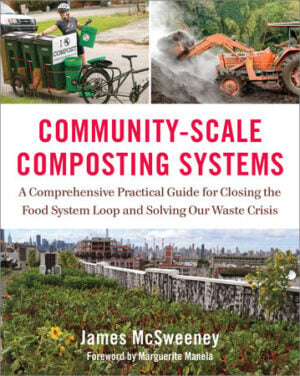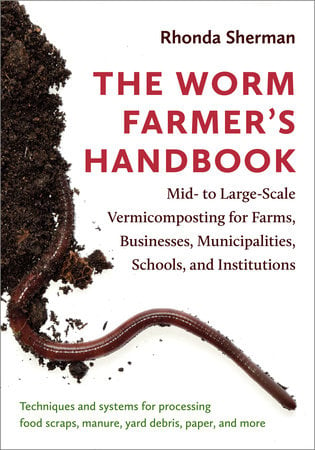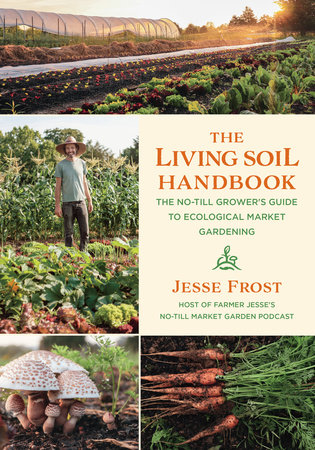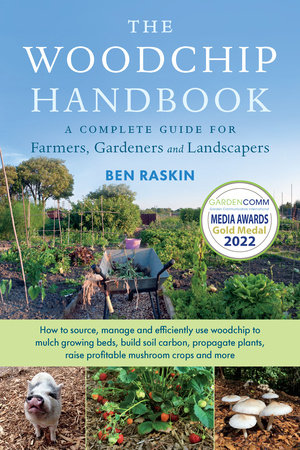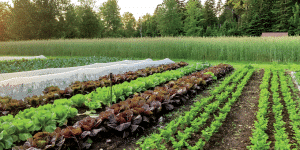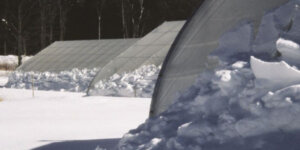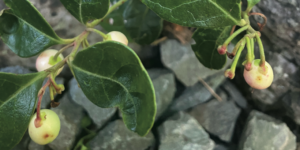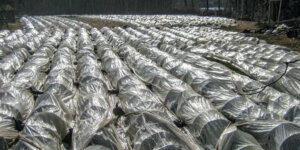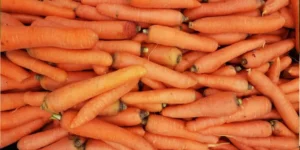The Phases of Composting
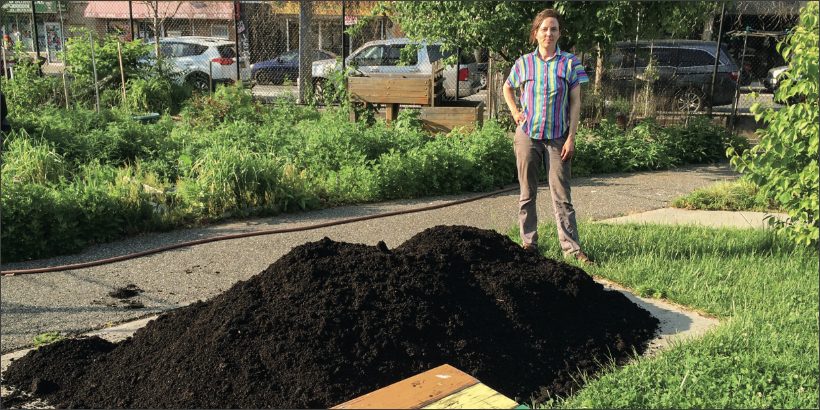
Although the stages of composting are very closely intertwined, each separate one has its own value and needs to be nurtured accordingly. The materials used go through several transformations: physical, biological, and chemical. Understanding each phase of this process is the first step in creating the best nutrients for your plants.
The following is an excerpt from Community-Scale Composting Systems by James McSweeney. It has been adapted for the web.
The phases of composting as I have come to understand them from a functional standpoint include primary, secondary, finishing, and curing. While there are a variety of ways to interpret the phases of composting, this is the framing that I have found to be most useful as an operator, planner, and designer.
The primary, secondary, finishing, and curing phases are the essential phases of composting, whereas the others are auxiliary.
Primary Phase
• The first 2–6 weeks
• Longer if the process is stagnant
At this stage, fresh, raw compost has lots of readily available food for microbes. When these materials are combined following a good recipe, optimal conditions exist for microbes to consume and replicate. Bacteria proliferate as simple food sources such as sugars, carbohydrates, proteins, and fats are consumed.
As microbial activity increases, the massive release of metabolic energy raises temperatures above the mesophilic and into the thermophilic range, where resources including oxygen are rapidly depleted, necessitating intensive management including monitoring, aeration, and agitation. The heat generated allows operators to achieve temperature treatment targets, which is one of the defining characteristics of the primary phase.
All of this early pile activity is also essential to rapidly break down odorous compounds as they form. The better the starting recipe and the more active the management, the more rapid the breakdown of all compounds, including odors, will be. During the primary phase, containment of food scraps is essential. This is achieved through capping of piles with a compost biofilter or completely enclosing the compost, which is the concept behind in-vessel composters.
The primary phase has ended once the following goals have been reached:
1. Temperature treatment targets are met.
2. Strongly offensive odors are absent.
3. Potential food sources for vectors are mostly indistinguishable and no longer of interest.
4. Oxygen demand is reduced, and pile turning and aeration rates are less frequent.
Biological Phase
As the compost becomes active, there is a shift from mesophilic to thermophilic microbes. The mesophilic microbes that are present initially begin the process by breaking down readily degradable compounds and causing the compost temperature to begin rising. As the temperature grows, microbial populations multiply, reaching as high as 109 to 1010 per gram of compost (1 to 10 billion). Thermophilic bacteria remain dominant through the primary stage, as relatively simple food sources continue to be available.
Nitrogen Cycle
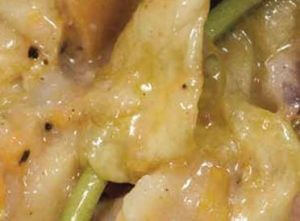
An up-close look at food scraps that have undergone the first stages of becoming compost. Photograph by Julian Post.
Nitrogen is present in its rawest and most volatile forms. Initially we expect much of the N to be in the form of lots of dead but temporarily stable proteins (in food, manure, hay). As these proteins break down, the by-products of protein degradation such as organic acids and ammonia (NH3) build. There may be volatile forms of N already present in the material, but this depends on the feedstocks. In manures, for example, a great deal of the conversion to ammonia and urea already took place in the animal.
A significant amount of N loss can take place in the primary phase. About 50 to 90 percent of all NH3 losses typically occur during the first weeks of thermophilic composting. Losses via NH3 volatilization can range from as low as 13 percent to as high as 70 percent of nitrogen in manure. Nitrogen losses from piles with a C:N ratio of 15:1 have been found to be as much as four times greater than from piles with a C:N ratio of 20:1.
Carbon Degradation
The simplest forms of carbon are quickly accessible to bacteria, which dominate in the primary phase. Sugars, starches, and fats are the most readily available forms of high C, the low-hanging fruit that drive the fast and hot energy cycles in the early stages of the process.
pH
As proteins and fatty acids degrade, acidic compounds volatilize and the pH typically drops significantly, sometimes to as low as 4.5.
Secondary Phase
• 4–10 weeks starting in months 0–2
• 2–4 months combined primary and secondary phases (or active phase if you prefer). Only in really unusual or unmanaged cases would active phases last longer.
Temperatures are still thermophilic (113°F or higher) and may even remain well above 131°F for some time, but your temperature treatment targets have already been met, which means at this point you are managing for product quality and operational efficiency. While oxygen demand is decreasing, some continued aeration is required to maintain aerobicity. At this stage, hungry microbes are eager to consume whatever residual odorous compounds are generated, so the risk of releasing offensive odors from the pile also decreases.
At the majority of operations, the secondary phase of composting is managed via turned windrows or turned piles. The main reasons for this are economic; other methods require a higher up-front investment. There are fewer associated risks in terms of odors and vectors in the secondary phase compared with the primary, and thus there are also fewer overall benefits from investing in more intensive methods compared with those required in the primary phase. Strategically, people target a disproportionate (yet appropriate) amount of infrastructure investment and management into the primary phase.
That said, more intensive methods can continue to speed up the process in the secondary phase. Two common examples are (1) vermicomposting succeeding a primary phase that meets temp treatment standards; and (2) secondary ASP following either a primary ASP or an in-vessel treatment phase.
The secondary phase has ended once the following goals have been reached:
1. Temperatures have dropped below 115 to 120°F.
2. Acrid smells are gone; some pleasant musky (such as pipe tobacco), moderate ammonia, or other benign smells may remain.
3. No visible food scraps/raw feedstocks remain other than wood and other highly recalcitrant materials.
Biological Phase
During the secondary phase, bacteria are still predominant, although their populations have likely peaked. Even at higher thermophilic temperatures, actinomycetes and some fungi begin the important role of breaking down woody materials.
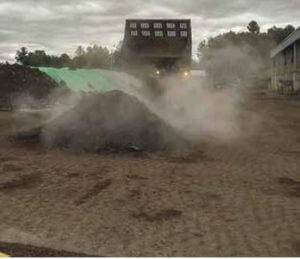
Following a primary ASP phase and prior to the secondary ASP phase, compost is temporarily windrowed so that moisture can be added using a water truck.
Nitrogen Cycle
The raw proteins have mostly been broken down and transformed into ammonia (NH3), which is very volatile. While N loss continues in this phase, it should be slowing and by the end of the secondary phase ammonia should be minimally detectable to the nose.
Carbon Degradation
The simplest forms of C have been consumed, and microbes have moved on to the more complex forms: cellulose, some waxes, and chitin. Lignin degradation is in its early stages.
pH
The drop in pH should be rebounding, and it will slowly continue to rise as organic acids are converted to CO2. Ammonia interaction may also play a role in raising pH. In the case of high-pH composts, the trend is also toward neutral.
Finishing
• 1–6 months starting in months 2–6
Very little management is required during the finishing stage. Oxygen demand is low, so it can remain fairly aerobic without active aeration as long as the material is not too wet, too dense, or stored in too large a pile. A couple of turns over a few months will go a long way toward keeping the process moving. Some turning will also help remediate wet and dense conditions (this is common prior to full completion) and ensure that the outside of the pile doesn’t fall behind the material in the core. There is very little that can go wrong at this stage, unless the material is sitting in a puddle or gets contaminated with weed seeds or leachate. If you’ve planned your operation well, these will not be issues, so your job is to monitor it occasionally and make sure that nothing gets in the way of its natural progression.
The finishing phase has ended once the following goals have been reached:
1. Your temperature maturity standard has been met—for example, a temperature no greater than 90°F following a turning.
2. The pile smells like rich forest soil.
3. Particles are reduced to crumb-size and smaller (other than large woody and other highly recalcitrant particles).
4. The total volume of material is significantly reduced, typically by greater than 50 percent.
Biological Phase
As the pile cools, the microbe population shifts back from thermophiles to mesophiles, corresponding to the drop in pile temperature. Total bacteria populations decrease dramatically as simple food sources dwindle. Meanwhile the role of fungi increases, breaking down the more complex forms of carbon such as woody particles. Optimal temperatures for lignin decomposition in composting are between 104 and 122°F, right on the boundary between thermophilic and mesophilic. It is not uncommon to see worms inhabit the cooler regions of the piles at this stage, sometimes in large quantities. As the pile continues to mature, there is a shift to higher-trophic-level organisms. Compost’s disease-suppressive qualities have been attributed to this shift.
Nitrogen Cycle
In compost, as in soils, there are specialized bacteria that convert ammonia N (NH3) into nitrite (NO2-), then nitrate (NO3-) in a process called nitrification. Nitrite and nitrate are more chemically stable forms of plant-available N than ammonia. The role of these bacteria in mediating N stabilization increases fairly late in the process, as temperature drops and maturation commences. As the compost continues to mature, there is very little ammonia left, and nitrite and nitrate increase. Eventually the majority of the nitrogen becomes “organic” once again. The common understanding is that the N in mature compost is contained primarily in the proteins of living organisms. Bacteria are reportedly 7 to 11 percent N and fungi 4 to 6 percent on a dry-weight basis. As long as the compost is not mishandled (say, saturated with water), these living nitrogen sources are considered very stable.
Carbon Degradation
Any carbon that remains at this stage of the process was not readily consumable: mainly lignin (woody cell walls), some waxes, and other complex secondary plant compounds. While these compounds continue to slowly degrade, the rate of C consumption has greatly decreased.
pH
The compost continues to balance itself, acidic conditions becoming more alkaline and vice versa in a gradual progression toward neutral.
Curing
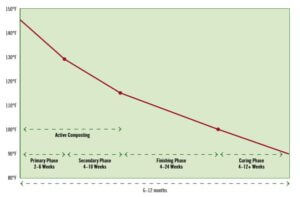
The time range for typical compost phases in managed systems.
• 1+ months starting at 4–9 months
For farmers making compost for themselves, I think taking the time for curing is a no-brainer. Adding quality with no additional effort makes sense when the end volume matters less than the end quality. If you are selling compost, you might set a standard curing time, say a month past the point when compost is finished; then anything beyond a month is gravy. In reality, the seasonality of compost use forces composters to cure certain batches for longer than they might otherwise. Nevertheless, there is always a batch that is just barely approaching salability in the springtime. You want to know ahead of time what the standard is for what you sell, because there is always a temptation to sell as much material as possible.
If the four phases of composting as I’ve described them here feel overly complex, understand that the curing stage is your insurance policy. If some other stage of the process gets cut short, extra curing can make up for it. Curing can even act as a buffer for inadequate temperature treatment, because over time pathogens are outcompeted by other organisms or simply expire.
The curing phase has ended once the following goals have been reached:
1. Your temperature maturity and curing time standards have been met.
2. The compost has a fluffy, relaxed texture.
Biological Phase
Biologically, the curing phase is marked by an increase in higher-trophic-level biota. While bacterial populations decrease as the compost finishes, their populations are stabilizing during curing. As the compost ecosystem is given time to progress, microorganisms that feed on bacteria and other lower-level biota continue to increase. Well-cured compost can become a rich soil food web, with predators such as nematodes consuming lower in the food chain. Their excretions contain plant-available nutrients, providing a slow but consistent source of fertility.
Nitrogen Cycle
The soil nitrogen cycle continues, with ammonia being converted to nitrite, then nitrate, then into organic (living protein) forms. Organic N forms now dominate.
Carbon Degradation
Only the most stable and recalcitrant forms of carbon remain. Humification increases over time, producing highly stable and valued compounds like humic and fulvic acids.
pH
The compost may continue to balance itself, acidic conditions becoming more alkaline and vice versa, although this progression should be nearing or at a stable state.
Recommended Reads
Recent Articles
No heated greenhouse? No problem! Discover the secrets to thriving winter gardening without breaking the bank.
Read MoreWintergreen is the stunning evergreen groundcover that’s a game-changer for your garden! It’s cherished for its aromatic leaves, vibrant fall color & bright berries.
Read MoreYear-round growth without the hefty price tag of a greenhouse? Low tunnels are the cost-effective and flexible solution you’ve been looking for. Grow year-round with low tunnels!
Read MoreGrow winter carrots for a sweeter & more flavorful harvest! Ditch the bland, store-bought carrots this winter! Grow your own winter carrots for a sweeter and more flavorful twist 🥕🥕
Read More

